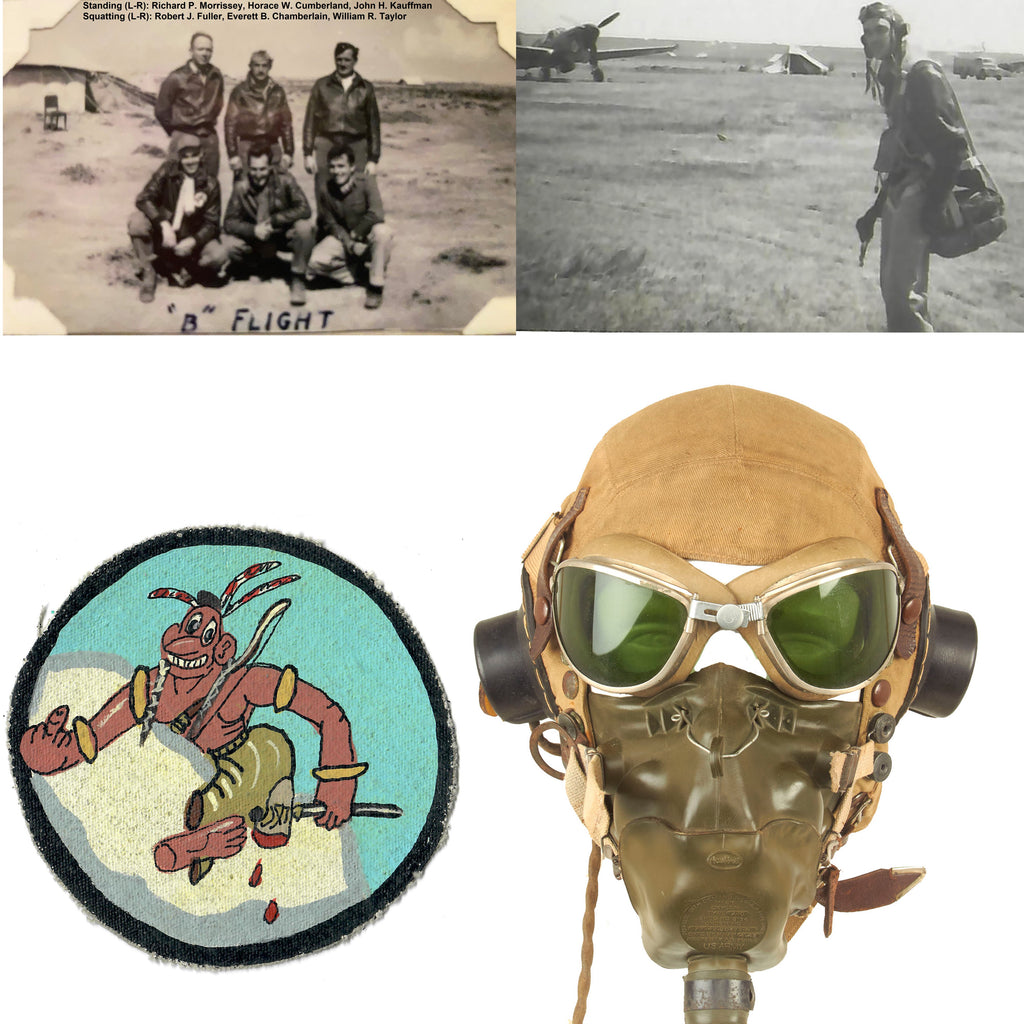Item Description
Original Items: Only One Group Available. Now this is a fantastic flight helmet grouping. The grouping belonged to Captain Robert John Fuller of the 86th Fighter Squadron under the 79th Fighter Group. The squadron was first activated shortly after the United States entered World War II as the 86th Pursuit Squadron. As the 86th Fighter Squadron It saw combat in the Mediterranean Theater of Operations and earned two Distinguished Unit Citations. After the end of the war it became an element of the occupation forces until returning to the United States, where it was inactivated in 1947.
The Items In This Lot:
- Modified British WWII RAF Type D Flying Helmet With Goggles: This is a very interesting piece. The flight helmet is an original British Type D “Tropical” which was utilized by Captain Fuller and can be seen with it in the original photo accompanying the group. The headphones/ear cups appear to have been removed from an American A-11 flight helmet which were cut to shape and sewn to the helmet. The avionics were better reinforced with a piece of plexiglass on each side as well as a rubber buffer to mitigate any movement. The overall condition of the helmet is as expected, well worn with staining but is presented without any extensive damage. The chinstrap is still present and the oxygen mask snap buttons on the helmet are oxidized from age, so if you wish to properly attach the mask they would need to be cleaned. The goggles are an early war tear drop example in remarkable condition for the age.
- A-10 Oxygen Mask Dated 1943: A lovely example with signs of moderate use without any extensive damage. The plus and hose are still solid and undamaged.
- 79th Fighter Group Book
- High Quality 86th Fighter Squadron Painted Patch By RKO Movie Studio: A fantastic reproduction of a rather rare squadron patch. The patch features an image of a Native American flipping the middle finger while standing on a cloud with a bloody tomahawk in hand.
- 3 ½” x 2 ¾” Photograph: The photograph is of Captain Fuller standing on a grass airfield wearing the same helmet, goggles and mask that are featured in this grouping.
- Letter From Daughter: She states in the letter that the helmet grouping is the same featured in the photo. She also talks about how he was awarded the Distinguished Flying Cross with 7 Oak Leaf Clusters. At the bottom she says she has a photo (not present) of General James Doolittle pinning the DFC on Captain Fuller in Tunis.
A lovely grouping that comes more than ready for further research and display.
The squadron was first activated in early 1942 at Dale Mabry Field, Florida as the 86th Pursuit Squadron, one of the original three squadrons of the 79th Pursuit Group. Its initial cadre was drawn from the 56th and 81st Fighter Groups. The squadron was redesignated the 86th Fighter Squadron in May 1942. The unit trained in the United States, then moved to Egypt by sea via Brazil in October–November 1942, where it became part of Ninth Air Force.
The squadron trained with P-40 Warhawks while moving westward in the wake of the British drive across Egypt and Libya to Tunisia. By escorting bombers, attacking enemy shipping, and supporting ground forces, the 86th took part in the Allied operations that defeated Axis forces in North Africa, captured Pantelleria, and conquered Sicily. The squadron was awarded a Distinguished Unit Citation (DUC) for its support of British Eighth Army during that period, March–August 1943.
The squadron became part of Twelfth Air Force in August 1943 and continued to support the British Eighth Army by attacking troop concentrations, gun positions, bridges, roads, and rail lines in southern Italy. It operated in the area of the Anzio beachhead from January to March 1944. The unit participated in the drive on Rome from March to June 1944, and converted to P-47 Thunderbolts during that time. It flew escort and strafing missions in southern France during August and September 1944, and afterward returned to Italy and engaged in interdiction and close air support operations in northern Italy. The 86th received a second DUC for numerous missions flown at minimum altitude in intense flak to help pierce the enemy line at the Santerno River in Italy in April 1945. Squadron pilots were credited with twenty-eight victories over enemy aircraft during World War II.
The squadron remained overseas as part of United States Air Forces in Europe after the war as part of the occupation forces. It was transferred, without personnel and equipment, to the US in June 1947 and inactivated on 15 July 1947.
- This product is available for international shipping.
- Eligible for all payments - Visa, Mastercard, Discover, AMEX, Paypal & Sezzle



























